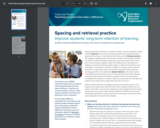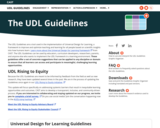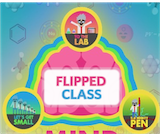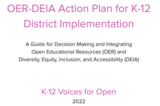
A guide on how to optimize learning outcomes
- Subject:
- Education
- Material Type:
- Teaching/Learning Strategy
- Author:
- Aneta Dobrzyńska
- Date Added:
- 07/31/2023

A guide on how to optimize learning outcomes

A guide on how to optimize learning outcomes Ένας οδηγός για το πώς να βελτιστοποιήσετε τα μαθησιακά αποτελέσματα

This article discusses research findings about classroom questioning and provides tips for teachers and online and print resources.

In this resource, you will learn what routines are and how to establish them in your daily schedule, how to decide how much time you spend on a section of your day to increase instructional time, and the importance of including brain breaks throughout the day.

Spacing and retrieval practice can improve students’ long-term retention of their learning. This guide outlines key practices for using spacing and retrieval in the classroom:
Make sure learning retention is maximised by spacing learning across lessons.
Prompt your students to recall information in different ways to enhance long-term retention.
Plan your lessons around routines.

This template is part of the K-12 Voices for Open OER-DEIA Action Plan for K-12 District Implementation. The template, and the entire guide, is intendend as a strategic planning tool for district leaders wishing to promote the already pedagogically and financially compelling practice of creating or adapting open educational resources (OER) to help achieve district goals in serving all students through diversity, equity, inclusion, or accessibility (DEIA) lens. The guide provides step-by-step planning tools, including examples, templates, and resources to help district leaders articulate and establish action plans for what we refer to as "OER-DEIA." The entire guide is an open educational resource itself, free and openly licensed for reuse, remixing, and resharing.

This template is part of the K-12 Voices for Open OER-DEIA Action Plan for K-12 District Implementation. The template, and the entire guide, is intendend as a strategic planning tool for district leaders wishing to promote the already pedagogically and financially compelling practice of creating or adapting open educational resources (OER) to help achieve district goals in serving all students through diversity, equity, inclusion, or accessibility (DEIA) lens. The guide provides step-by-step planning tools, including examples, templates, and resources to help district leaders articulate and establish action plans for what we refer to as "OER-DEIA." The entire guide is an open educational resource itself, free and openly licensed for reuse, remixing, and resharing.

This template is part of the K-12 Voices for Open OER-DEIA Action Plan for K-12 District Implementation. The template, and the entire guide, is intendend as a strategic planning tool for district leaders wishing to promote the already pedagogically and financially compelling practice of creating or adapting open educational resources (OER) to help achieve district goals in serving all students through diversity, equity, inclusion, or accessibility (DEIA) lens. The guide provides step-by-step planning tools, including examples, templates, and resources to help district leaders articulate and establish action plans for what we refer to as "OER-DEIA." The entire guide is an open educational resource itself, free and openly licensed for reuse, remixing, and resharing.

The UDL Guidelines are a tool used in the implementation of Universal Design for Learning, a framework to improve and optimize teaching and learning for all people based on scientific insights into how humans learn. Learn more about the Universal Design for Learning framework from CAST. The UDL Guidelines can be used by educators, curriculum developers, researchers, parents, and anyone else who wants to implement the UDL framework in a learning environment. These guidelines offer a set of concrete suggestions that can be applied to any discipline or domain to ensure that all learners can access and participate in meaningful, challenging learning opportunities.

This learning activity is designed to be used in a large introductory chemistry course, as part of a larger module of learning activities that includes prior viewing of an interactive instructional video. Instructional videos are to be viewed before class meetings. During class time, students work in small groups and discuss the presented information and question prompts, and will build upon the concepts discussed in that video in order to develop a new, extended concept.Students should be tasked with working together to complete the prompts in each section of the activity by a set time limit. After each section is completed, the entire class can share their answers via a personal response system, and the instructor can review and explain the correct responses, using the accompanying slide deck, which translates the problems into multiple-choice prompts.Instructional resources include 1) interactive instructional videos (these can be embedded directly into the learning management system) 2) the learning activity (.docx and .pdf) 3) the learning objectives (.docx and .pdf) and 4) the slide deck (.pptx). - Chemical Bonding- Resonance - Intermolecular Forces- Collision Theory- Equilibrium- Nucleophiles and Electrophiles

Kelly Hammond, Open Educational Resources (OER) and Instructional Technology Adjust at CUNY School of Professional Studies, talks about the importance of developing a strategic introduction to the OER-DEIA Action Plan for K-12 District Implementation that provides users with critical information that gives them a solid foundation when beginning their OER-DEIA journey. As she developed this section of the guide she reflected on her own OER journey and asked herself the guiding question, "What would I have needed to know in order to get there faster and more comfortably?"

Tracy Rains, Virtual Learning Specialist at Appalachia Intermediate Unit, talks about developing two key components of the OER-DEIA Action Plan for K-12 District Implementation: The Collaboration Plan and the Educator and Staff Professional Learning Plan. She provides insight into why both of these sections are critical to the success of any OER-DEIA initiative.

This video provides an overview of the K-12 Voices for Open OER-DEIA Action Plan for K-12 District Implementation. Amee Evans Godwin of ISKME and Rebecca M. Henderson of the Westmoreland Intermediate Unit provide you with an overview of the work being done by K-12 Voices for Open, the purpose of this guide, and the process of developing the guide. Finally, they walk you through the nine sections of the K-12 Voices for Open OER-DEIA Action Plan for K-12 District Implementation, and explain the ways in which the sections can be used by districts.

Instructional designers support students through the use of scaffolding. Learn about the Zone of Proximal Development and how scaffolding supports this theo...

an interactive worksheet about the types of shops